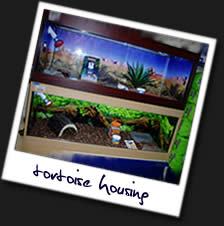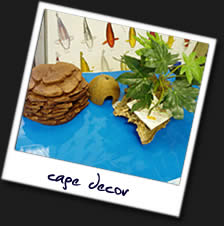www.reptiles-info.co.uk
Leopard Tortoise Housing:
In order to make sure that your leopard tortoise is housed correctly, here at reptiles-info we have produced our very own guide to take you through the stages that are involved with housing a leopard tortoise from a baby to an adult.
Cage Setup:

There are many different ways to house your leopard tortoise firstly you can house your tortoise outdoors or indoors, however unless you live in a country with a hot climate all of the year round it is not possible to house your tortoise outdoors although you may be able to house your tortoise outside during the summer months. If you are housing your tortoise indoors there are a few options that you have at your disposal firstou you could buy an aquarium for your leopard tortoise this will be fine whilst your tortoise is a baby/juvenile as it will enable you to create the correct environment for the tortoise and will be large enough for the leopard tortoise to manuever. As your leopard tortoise grows the aquarium will become to small for the reptile and will need to be relocated to a bigger enclosure. I would advise that you custom build your own housing as purchasing one direct from a store can be expensive due to its size. The type of cage setup that you should be looking to create is a large 'tablebox' made out of wood that allows the tortoise to move freely. Also to make a successful environment for your leopard tortoise you will need to think about the cage size, heating, lighting, ventilation, decor and cleanliness and hygiene of your tortoises cage all of which are covered in detail below.
Cage Size:
The size of your leopard tortoises housing should vary depending on the size of the tortoise itself. As a baby an aquarium that measures around 24inches x 24inches will be an adequate size to house your leopard tortoise however tortoises can grow rapidly if fed correctly and will need to be moved to much larger housing as they grow into adults. The minimum size that i would advise for your adults housing should be around 4ft x 8ft / 120cm x 240cm as this is an excellent size to house all of the necessary items that you leopard tortoise will need and enable enough room for exercise.
Heating:
To provide the correct amount of warmth for your leopard tortoise I suggest that you aim to keep the temperature of your tortoise's housing above 21°C with a warm area within the housing that does not exceed 32°C as this would be too hot for you tortoise and may lead to burns. You should also lower the temperature of your tortoise's housing to between 21°C and 24°C. A hotspot is need in your tortoise's housing as it will offer a warmer area within the enclosure that can be used for basking which helps to aid the tortoises digestion. The hotspot should be positioned at one end of the tortoise's housing as this will help to create a temperature variation and if the tortoise is too hot it can move to the cooler area of the tank. To provide this extra heat you can use a spot lamp, ceramic heater or a habistat heat mat placed underneath the tortoises housing.
For More Information On Reptile Heating Click Here

Lighting:
The amount of light that your tortoise is exposed to has a great impact on the health and well being of your reptile as if the tortoise does not recieve enough UV light it will be unable to produce enough vitamin D3 which is needed for the tortoise to survive. Therefore it is vital that you install a UVB light into your tortoise's housing so that it can recieve enough UV light to enable it to produce the neccessary vitamins needed in order to stay healthy. For More Information On Reptile Lighting Click Here
Ventilation:
The humidity of the tortoises enclosure is not as important as other reptiles as tortoises do not like to be in damp or constantly high humid conditions. However a well ventilated tortoise housing should always be the aim so that you can ensure your tortoise has a constant supply of fresh air.
Cage Decor:

To create an environment that is as close as possible to that of it natural habitat of a leopard tortoise you should include in your housing a good quality substrate this can range from using hay which is good for the tortoise if it nibbles on it, paper towelling, newspaper and carpeting are all good forms of substrate. You may also use sand as a substrate however when feeding your tortoise place the food ontop of another object so the tortoise does not eat any of the sand. Other items that are useful in a tortoise's cage would be a hide box in the cage which helps to provide a secure area and another variation in temperature. In order to make the housing look more natural repti-vines, logs, ledges and logs can all be added into the housing, you must also check that these items are in a secure place otherwise they could move and hurt your leopard tortoise. A water bowl should also be housed within the caging.
Cage Cleanliness:
It is best to maintain your leopard tortoise's housing by regularly scheduling a routine clean once or twice a week. This would involve cleaning all non-porous surfaces with vetaclene and I advise that any item that can't be easily cleaned should be removed from the tank completely.
Leopard Tortoise Pages






